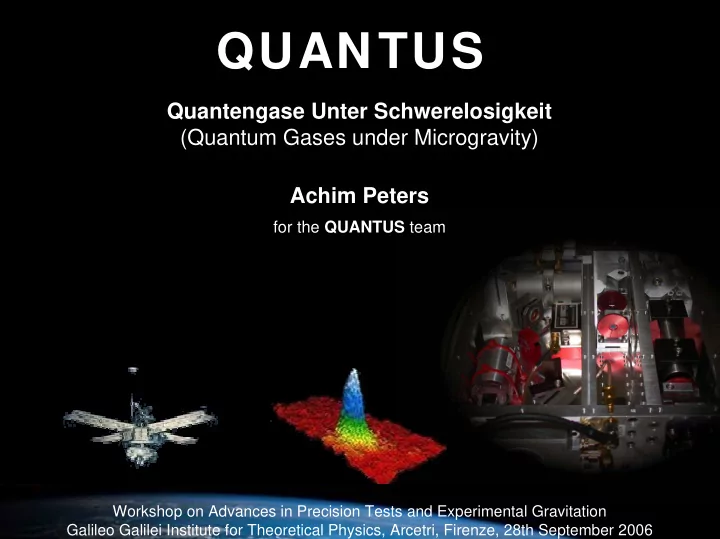

QUANTUS Quantengase Unter Schwerelosigkeit (Quantum Gases under Microgravity) Achim Peters for the QUANTUS team Workshop on Advances in Precision Tests and Experimental Gravitation Galileo Galilei Institute for Theoretical Physics, Arcetri, Firenze, 28th September 2006
The QUANTUS Team Universität Hamburg ZARM & Universität Bremen Humboldt Universität Universität zu Berlin Hannover Funding: Universität Ulm MPI für Quantenoptik Garching / München DLR 50 WM 0346
BEC in Free Fall: Shifting the Frontiers in Physics Longest tim e of flight for quantum objects Low est tem peratures/ energies Largest quantum objects
Long Evolution Time � High Sensitivity |e 〉 |g 〉 time T 2T 0 Signal at the output ports ⎧ T for frequency, recoil, rotations ∝ ∝ ⎨ S f ( T ) 2 ⎩ T for gravity, gravity gradients See e.g. : Ch. J. Bordé, Gen. Rel. Grav. 3 6 , (2004), 475
Lowest Energy Scales 10 -38 10 -20 10 -23 10 -26 10 -29 10 -32 10 -35 J 10 -13 10 -16 10 -19 10 -22 10 -25 10 -28 GeV 10 -15 10 3 10 0 10 -3 10 -6 10 -9 10 -12 K current record: 450 pK W. Ketterle et al. QUANTUS "classical" macroscopic "quantum" ? ? phase quantum phase transitions phenomena transitions
New Length Scales individual individual macroscopic matter QUANTUS particles wave packets wave λ v dB d λ < λ dB < λ dB > r d d sub mm scale mm to cm scale dB cl ? ? - coherence limits ? - granularity precision - space time fluct. ? classical macroscopic measurements gas coherence - ....
The ZARM Drop Tower Free Fall: up to 4.5 sec Duration > 1 BEC-Experiment 3 flights per day Test of a robust BEC Facility Dimensions < 0.6 ∅ x 1.5 m Height 110 m
The ZARM Katapult Doubling the Free Fall Time to 9 seconds …
110 m ~ 4.74 s at µg acceleration 110 m ~ 4.74 s at µg acceleration Experimental Environment
The Challenge … Drop capsule boundary conditions Laser Electronics Vacuum Computer h = 1.73 m A typical BEC laboratory experiment d = 0.6 m av. Power < 280 W Drop capsule Weight < 274 kg
Laser System Two frequency ranges 4 m odules required for 87 Rb BEC E F 2 spectroscopy 3 stabilized 2 5 2 P 3/2 1 master laser 0 Pumping, Detection Cooling, Repumper Beat stabilized 6.8 GHz MOPA amplifier module 2 5 2 S 1/2 Distribution 1 Module (AOM)
Mechanically Stable Optical Components 26 cm 2 cm
Laser Modules DFDL master module FM master module MOPA module
Completed Laser System 45 cm • all components are integrated in the system • laser modules guarantee a flexible setup • robust laser design for drop tower experiments
Drop Tower Tests of Laser System error offset [V] 0,4 0,0 9 -0,4 8 7 error DAVLL [V] 0,1 6 PDM2HHr [V] 0,0 5 -0,1 4 3 0,4 error MTS [V] 2 0,2 0,0 1 -0,2 0 -0,4 -1000 0 0 1000 2000 2000 3000 4000 4000 5000 6000 6000 7000 4 time [ms] z-acceleration [g] 2 0 fiber coupling stability during the flight -2 -20 0 20 40 60 80 time [ms] frequency stability test during release
Laboratory Tests of Laser System Magnets drop hight ca. LASER linear ball 1,2m bearing damping design: Katharina Elbs
Laboratory Tests of Laser System 0,0 0,5 1,0 1,5 50 1,0 0,9 40 0,8 30 correction [V] 0,7 20 z-acceleration [g] 0,6 0,5 10 0,4 error / 0 0,3 -10 0,2 0,1 -20 0,0 -30 -0,1 0,0 0,5 1,0 1,5 time [s]
Laboratory Tests of Laser System 50 40 30 20 10 0 0,30 0,25 0,20 time [s] 0,15 0,10 0,05 0,00 50 40 30 20 10 0 z-acceleration [g]
Laboratory Tests of Laser System 50 50 50 50 40 40 40 40 30 30 30 30 recapture of z-acceleration [g] the capsule 20 20 20 20 10 10 10 10 0 0 0 0 0,00 0,00 0,00 0,05 0,05 0,05 0,10 0,10 0,10 0,15 0,15 0,15 0,20 0,20 0,20 0,25 0,25 0,25 0,30 0,30 0,30 time [s] time [s] time [s]
Laboratory Tests of Laser System 50 50 50 50 40 40 40 40 30 30 30 30 Fallturm Aufprall z-acceleration [g] 20 20 20 20 Katapult 10 10 10 10 0 0 0 0 0,00 0,00 0,00 0,05 0,05 0,05 0,10 0,10 0,10 0,15 0,15 0,15 0,20 0,20 0,20 0,25 0,25 0,25 0,30 0,30 0,30 time [s] time [s] time [s]
Drop Capsule Integration
Experiment Chamber Modified Iongetterpump (20l/ s) to withstand strong forces (50g at impact) Pressure in the lower 10 -10 mbar regime Single chamber design for size minimization Fully fiber coupled Robust coil arrangement
Mirror MOT
Atom-Chip-MOT 7 1,4x10 • 12·10 6 atoms loaded into the external MOT, 7 1,2x10 • 85% transfer efficiency into chip-MOT, 7 1,0x10 • 40mK temperature after molasses-cooling, 6 8,0x10 atoms • transfer to magnetic trap, 6 6,0x10 6 • evaporative cooling (in progress) 4,0x10 optimized 6 2,0x10 200 µm displacement between MOT and U-MOT 0,0 -60 -6 -4 -2 0 2 4 6 time after loading on the chip [ms]
Outlook: Drop BEC Experiments Next Steps: - Evaporation and realization of lab BEC - Transfer to the ZARM drop tower - First BEC under microgravity First experimental questions: - Large scale time of flight expansion and interference - Adiabatic trap expansion for lowest temperatures - Equivalence of free fall and "free" space
The QUANTUS Team
Recommend
More recommend